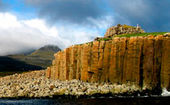Largest near-Earth objects are already well characterized, but smaller ones could surprise
© NASABIG BUT RARE: Luckily for us, meteorite impacts such as the one that formed 45-mile-wide Manicouagan Crater in Canada are quite infrequent.
In 1998, the year
Deep Impact and
Armageddon dueled for the attentions of apocalypse-from-the-heavens moviegoers,
Congress tapped NASA to prevent such a cosmic cataclysm from becoming reality. The space agency was charged with cataloguing over the next decade the vast majority of nearby space objects larger than 0.62 mile (one kilometer) in size - those asteroids, and more rarely comets, capable of inflicting catastrophic damage to Earth.
Eleven years later - just behind schedule - the task appears to be nearly complete. Congress had requested that 90 percent of these large near-Earth objects (NEOs) be catalogued, and around 800 of them, roughly 80 to 85 percent of the entire population, have been tallied. (Astronomers can estimate how much of the lot has been surveyed by studying the gradual drop-off in discovery rates.) According to
NASA's impact-threat catalogue, only two of the kilometer-size NEOs so far identified pose a very slim risk in the next century; the more threatening of the two has a one in 116,000,000 chance of colliding with Earth. (That object,
known as 2009 CR2, was just discovered last week; with further observation it may prove not to be a threat at all.)

